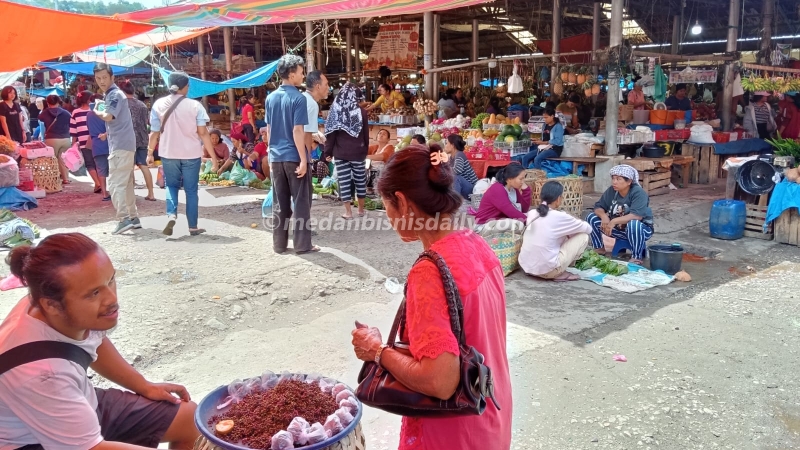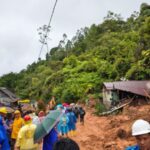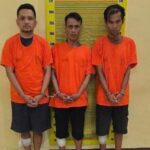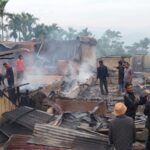The prices of several staple commodities at Pangururan Market in Samosir Regency, North Sumatra, have risen by an average of Rp 5,000 compared to last week.
The upward trend has been ongoing since early August due to reduced supply from outside the region caused by prolonged drought.
“Most of the commodities we sell come from outside Samosir, such as Tanah Karo and Dairi,” said a vegetable trader.
Prices are adjusted based on supply conditions from farmers. “Many commodities have increased, especially chili and shallots,” they explained.
The most noticeable increase is in shallots. “Last week, it was Rp 43,000 per kilogram, but today it reached Rp 48,000.”
Bird’s eye chili has also seen a sharp spike, now selling at Rp 45,000 per kilogram compared to Rp 35,000 last week.
The rise in staple commodity prices in Samosir Regency is a result of the prolonged dry season, leading to widespread crop failures. As a result, supplies from outside Samosir, such as Dairi and Karo Regencies, dominate the market.
Current Prices of Staple Commodities at Pangururan Market:
- Red chili Rp 33,000/kg
- Long beans Rp 20,000/kg
- Green beans Rp 15,000/kg
- Cucumber Rp 12,000/kg
- Green eggplant Rp 8,000/kg
- Purple eggplant Rp 7,000/kg
- Tomato Rp 9,000/kg
- Napa cabbage Rp 8,000/kg
- Broccoli Rp 18,000/kg
- Carrot Rp 6,000/kg
- Ginger Rp 18,000/kg
- Garlic Rp 33,000/kg
- Onion Rp 29,000/kg
- Cabbage Rp 5,000/kg
Pangururan Market
Pangururan Market is a bustling traditional market located in Pangururan, the capital of Samosir Island on Lake Toba in North Sumatra, Indonesia. It serves as a key trading hub for the local Batak community, offering fresh produce, handmade crafts, and regional specialties. The market reflects the area’s cultural heritage and plays a vital role in the daily life and economy of the surrounding villages.
Samosir
Samosir is a large volcanic island in Lake Toba, North Sumatra, Indonesia, and is part of the Batak cultural heartland. Historically, it was the center of the Batak Kingdom and is considered the ancestral home of the Batak people, known for their unique traditions, traditional houses, and vibrant music. Today, Samosir is a popular tourist destination, offering scenic landscapes, cultural attractions, and insights into Batak heritage.
North Sumatra
North Sumatra, located in Indonesia, is a diverse region known for its stunning natural landscapes, including Lake Toba—the world’s largest volcanic lake—and the lush rainforests of Gunung Leuser National Park. Historically, it was home to the Batak kingdoms and later became a significant trade hub under Dutch colonial rule. Today, it is celebrated for its rich indigenous Batak culture, vibrant traditions, and unique architectural heritage.
Tanah Karo
Tanah Karo is a region in North Sumatra, Indonesia, known for its fertile highlands and vibrant Karo Batak culture. It is home to traditional villages like Lingga and Dokan, where visitors can see distinctive Karo architecture, including longhouses and ornate rice barns. The area also has a rich history tied to the Batak Kingdom and Dutch colonial influences, with attractions like the active Sibayak Volcano drawing tourists.
Dairi
“Dairi” (内裏) refers to the imperial palace complex in Kyoto, Japan, which served as the residence of the Emperor during the Heian period (794–1185). It was the center of political and ceremonial life, housing the emperor’s living quarters, government offices, and ceremonial halls. Though the original structures were destroyed over time by fires and wars, the site remains historically significant, with parts of its layout preserved in Kyoto’s Imperial Palace (Kyoto Gosho) today.
Karo Regencies
The Karo Regencies (Kabupaten Karo) are located in North Sumatra, Indonesia, and are home to the indigenous Karo people, known for their rich cultural traditions and distinctive longhouses. The area is historically significant as part of the ancient Karo Kingdom and is famous for its highland scenery, including the active volcano Mount Sinabung. Today, the region attracts visitors for its cultural heritage, traditional villages like Lingga, and agricultural products like coffee and citrus fruits.






